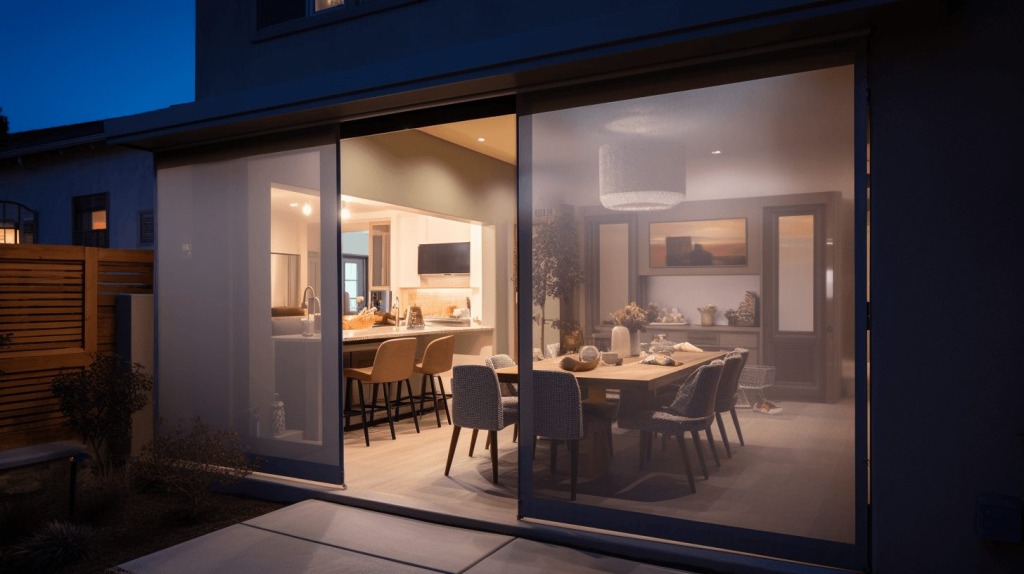
Retractable screens enhance airflow and views in homes and businesses while protecting against insects when needed. The global awnings market—which includes retractable screens—is currently valued at USD 10.1 billion and is projected to grow at a compound annual growth rate (CAGR) of 5.31% from 2025 to 2033, highlighting the increasing demand for energy-efficient and versatile shading solutions [1]. With this growth trajectory, understanding when and how to use retractable screens becomes increasingly relevant. This article will explore five key points on balancing the usage of retractable screens.
The Ability to Adjust to Changing Conditions
One of the most significant advantages of retractable screens is the ability to adapt to changing conditions, unlike traditional fixed screens. Homeowners can keep them open when extra air circulation or unobstructed views are preferable, such as on cool evenings or sunny days. Retractable screens can provide insect protection, like entertaining outdoors on warmer nights. Businesses also benefit from adjustability, allowing customers unimpeded access to products/services during operating hours while deterring insects at other times. Understanding retractable screens’ flexibility enables maximizing openings when favorable and protection when warranted.
Knowing how to optimize retractable screen usage around changing conditions allows homeowners and businesses to utilize their strengths fully. Tracking weather patterns, schedules, and types of activities happening in a space guides intelligent operation. Homeowners may open retractable screens more on consistently sunny days versus rainy periods to enhance daylight and views. Businesses can assess hours of customer traffic versus downtimes to guide daytime opening and nighttime closure. Routinely evaluating conditions impacting ventilation, visibility, and pest pressure needs ensures that screens are operated to match. When installing retractable screens, consider how their ability to adjust to changing weather conditions can provide sun protection and open-air enjoyment, says Sun Protection FL.
Providing Access While Deterring Pests
Retractable screens allow optimal access and visibility while closed, then roll away rapidly into protective housings when opened. This makes them ideal for locations requiring easy passage in and out of spaces yet deterring insect access when not in use. Doors and windows on homes, restaurants, medical offices, and other settings can benefit from easy access combined with pest control. Knowing how retractable screens balance these needs helps determine ideal placement and operation schedules. Closed during mosquito-prone periods or fly seasons, then opened for free movement when pest pressure subsides.
According to the U.S. Environmental Protection Agency (EPA), implementing Integrated Pest Management (IPM) strategies—like screening, sealing entry points, and eliminating sources of food and water—is essential in reducing pest problems in housing environments [2].
Understanding how to coordinate retractable screen operations around schedules, traffic patterns, and pest seasons further optimizes their dual functions. Homeowners can assess when high-traffic areas like back doors need frequent access versus low-traffic windows that can stay screened. Medical offices may determine patient volume patterns to expand open hours accordingly. Seasonal openings match usage to heavier pest pressures in warmer months and lighter needs in cooler times. The strengths of retractable screens shine when consumers know how to sync operational schedules with access requirements and pest deterrence needs.
Promoting Airflow When Possible
Because retractable screens have open mesh, they promote significantly better airflow when opened versus traditional fixed screens. This makes them advantageous in warmer climates where maximizing air circulation is a priority. Homes and businesses in these regions can open retractable screens on doors/windows when occupying indoor spaces to augment cross-ventilation. Closing them when spaces are unoccupied or pest deterrence is needed still provides protection.
The enhanced airflow retractable screens permit can have tangible effects on comfort and energy savings. Homes may require less air conditioning on hot days by opening screens to maximize natural air movement. This can lower utility bills. Commercial kitchens benefit from increased ventilation to manage heat buildup when cooking. Improved circulation from opening retractable screens also helps flush out indoor allergens and pollution when spaces are occupied.
A study published in Sensors found that insect screens with higher porosity can significantly improve airflow and support healthier indoor air quality by maintaining better natural ventilation while keeping pests out [3]. This underscores the importance of choosing screen designs that don’t compromise airflow for protection.
Tracking weather patterns and building occupancy provides the environmental context to know when maximizing openings for airflow brings the most advantages.
Allowing Natural Light While Containing Pests
The open mesh of retractable screens also allows more daylight into interior spaces versus fixed screens when opened. This natural light contains health benefits and reduces reliance on artificial lighting. Knowing this, homeowners and businesses should keep retractable screens open when occupying sunlit indoor areas to maximize daylight advantages, then close at night or when spaces are unoccupied. The screens contain insects even when closed. Intelligent operation means opening them to allow natural light in while present to enjoy it, then closing to deter pests otherwise.
Daylight transmitted through open retractable screens can help regulate human circadian rhythms and moods. Sunnier indoor environments are linked to lower rates of seasonal depression. Natural light also reduces eyestrain versus prolonged exposure to artificial lighting.
Research in Building and Environment emphasizes that screen porosity directly affects the balance between natural light penetration and ventilation efficiency, both of which are important for indoor comfort and energy savings [4]. Businesses like retail stores and offices can forego turning lights on until later in the day by maximizing daylight through open screens.
Homes and businesses should close screens overnight when spaces are unoccupied and daylight advantages no longer apply.
Matching Screen Usage to Events and Occupancy
One final tip for maximizing retractable screen benefits is matching their operation to events and occupancy. For homes, open them when entertaining guests outdoors, allowing easy access in and out of the home. Close when the party ends to deter late-night insects. For businesses, keep screens open during operating hours for customer access and product visibility and close after hours. Events like outdoor weddings can benefit from open screens for guest convenience, then closing afterward for pest protection when vacating. Syncing retractable screen usage to occupancy, hours of operation, and types of events ensure ideal access, visibility, and protection when needed.
Creating operational schedules around the activities occurring in a space results in ideal retractable screen usage. Homeowners can assess planned events like backyard barbecues and open screens accordingly for party access. Daycare facilities may sync screen operation to playground hours when children are outdoors versus nap times. Hotels can evaluate guest traffic patterns, opening screens more during busy check-in and check-out periods. Matching screen opening and closing to event schedules maximizes access and visibility when spaces are occupied while containing pests otherwise.
Retractable screens enable intelligent balancing of visibility, ventilation, access, and pest protection. Their flexibility allows openings when spaces are occupied for light and airflow. Closing them off-hours or in pest seasons maintains insect control. Routine assessments of conditions and schedules empower optimal operation. Retractable screens maximize advantages through adjustable alignments to the environment and needs.
Works Cited
- U.S. Environmental Protection Agency. “Pest Control Resources for Housing Managers.” EPA, https://www.epa.gov/safepestcontrol/pest-control-resources-housing-managers.
- Valença, D., et al. “Performance of Insect Screens for Natural Ventilation and Air Quality in Buildings.” Sensors, vol. 16, no. 8, 2016, article 1283. MDPI, https://www.ncbi.nlm.nih.gov/pmc/articles/PMC4883381/.
- Karava, Panagiota, et al. “Influence of Window Insect Screens on Wind-Driven Cross Ventilation.” Building and Environment, vol. 33, no. 7, 1997, pp. 391–398. Elsevier, https://www.sciencedirect.com/science/article/pii/S0378778897000650.






















